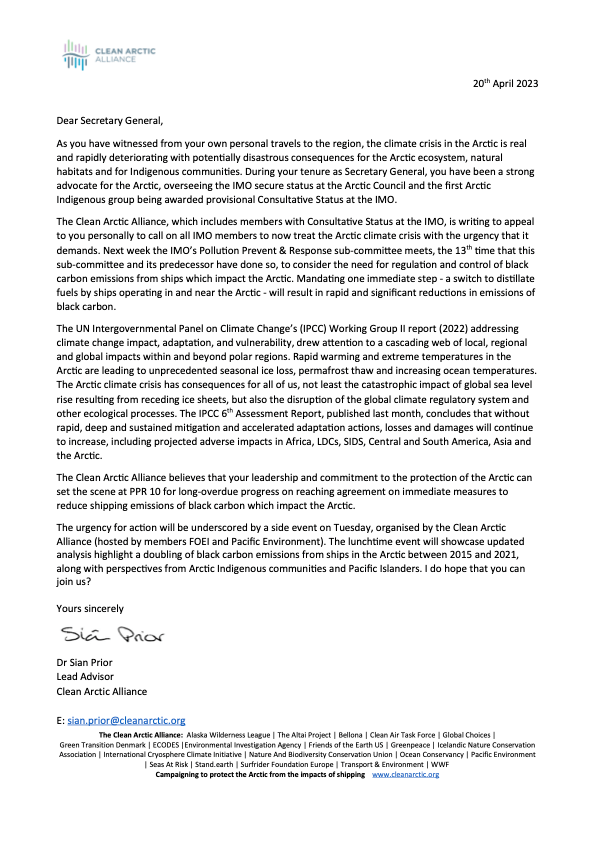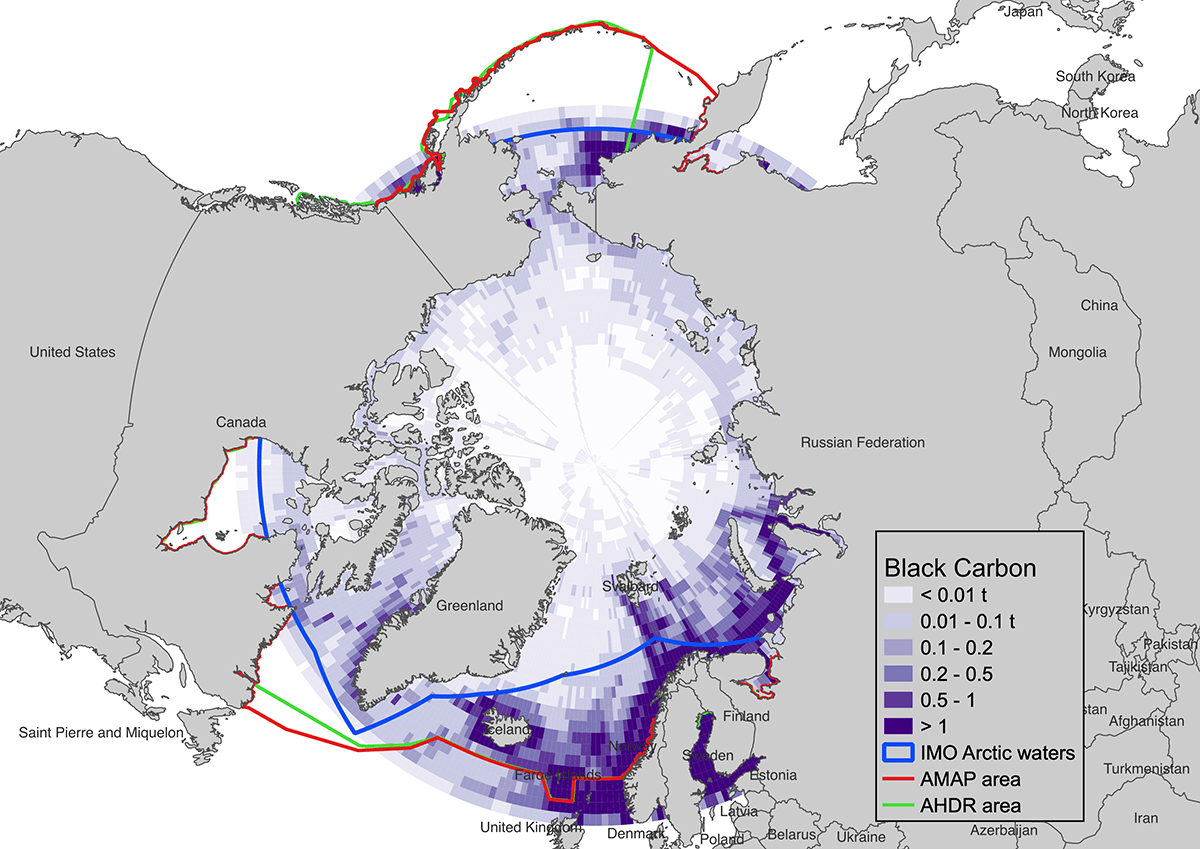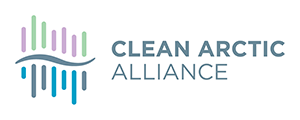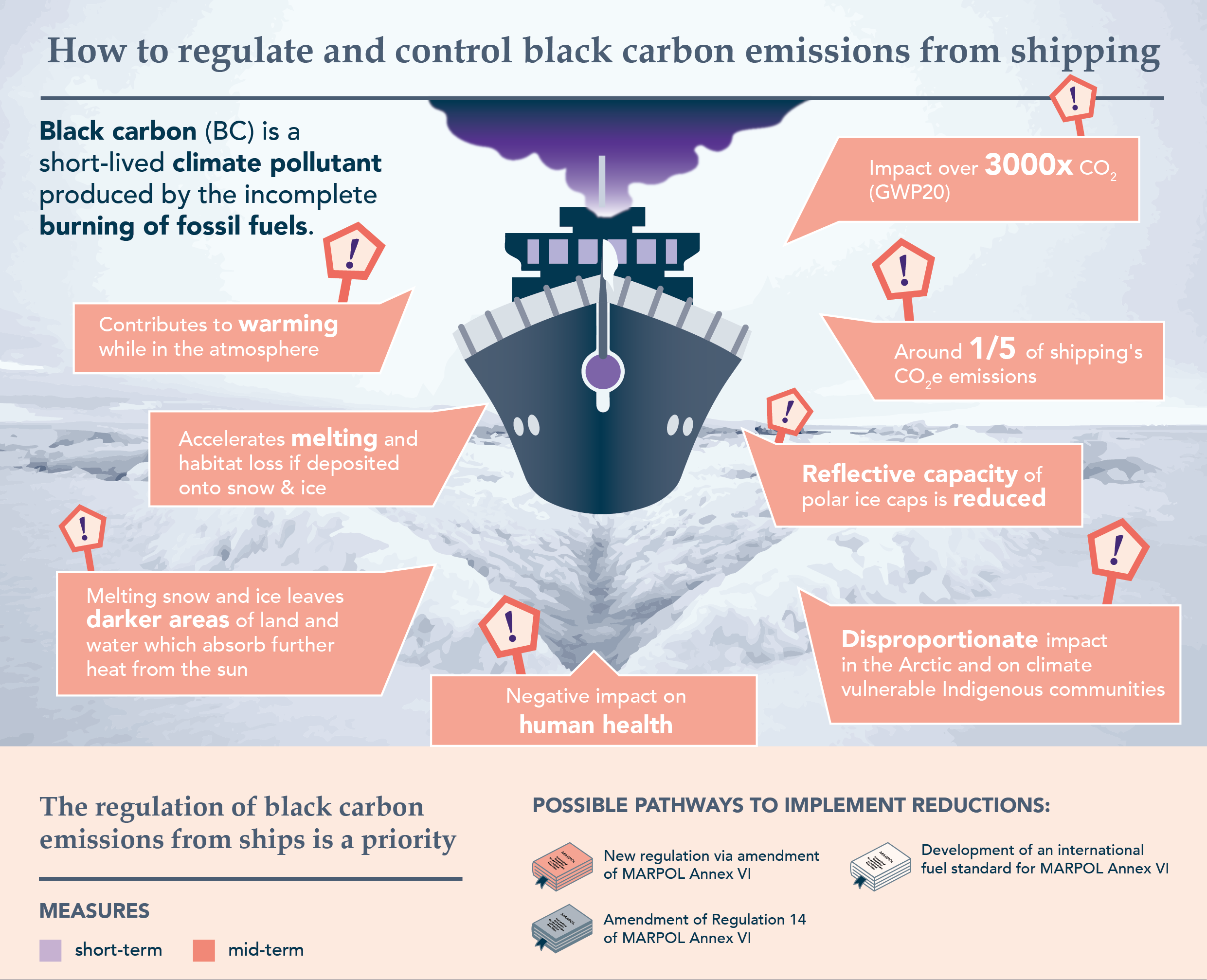See full infographic: How to regulate and control black carbon emissions from shipping
Read: In Celebration of the Life of Verner Wilson III
London, 24 April 2023:- As a meeting of the International Maritime Organization’s Pollution Prevention and Response committee opens today (PPR 10), the Clean Arctic Alliance [1] calls on the IMO to radically reduce the impact of black carbon emissions from shipping on Arctic sea and glacier ice, by putting in place a compulsory requirement for ships across the whole Arctic to use cleaner fuels, by switching to distillate fuels.
 This follows an open letter published by the Clean Arctic Alliance to IMO Secretary General Kitack Lim, asking him to personally call on all IMO members to now treat the Arctic climate crisis with the urgency that it demands.
This follows an open letter published by the Clean Arctic Alliance to IMO Secretary General Kitack Lim, asking him to personally call on all IMO members to now treat the Arctic climate crisis with the urgency that it demands.
“The reduction in black carbon emissions, which are a potent climate forcer, would be achieved through a mandatory fuel switch from dirty residual fuels to distillate fuels by ships operating across the broader Arctic, given the impact that shipping in and close to the Arctic regions can have on sea and glacier ice”, said Dr Sian Prior, Lead Advisor to the Clean Arctic Alliance, a coalition of 20 international non-profit organisations [2].
“The recent IPCC Synthesis Report makes clear that rapid, deep and sustained action is needed across all sectors [3]. To remain on or below a 1.5oC warming trajectory, ship climate impacts must be halved by 2030, with full decarbonisation close to 2040. This must include immediate cuts in black carbon emissions from ships, especially from those operating in and near to the Arctic”, said Prior.
“It is frustrating that the changes needed to rapidly reduce black carbon emissions from ships were not agreed and implemented when discussions on measures to reduce black carbon commenced over a decade ago,”she added. “Reducing black carbon emissions does not require the development of new fuels, or new technology, it simply requires cleaner fuel choices and the shipping sector catching up with what has been required of land-based power and transport systems for over a decade.”
The Clean Arctic Alliance also calls on IMO Members to bring forward proposals to designate Emission Control Areas (ECAs) in the Arctic and adjacent sea areas such as the north Atlantic where black carbon emitted from ships can reach the Arctic. Other measures that can reduce black carbon emissions in need of urgent action include the development of a strict aromatic fuel standard, as well as putting in place a requirement for installation of diesel particulate filters on ships operating in the Arctic.
“The Arctic, its wildlife and its people, are running out of time”, added Prior. “In 2010, the IMO Member States recognised the need for action to reduce black carbon emissions from ships – thirteen years later, the IMO must finally support mandatory action for measures that can be implemented quickly, such as a switch to cleaner fuels and use of filters, designation of emission control areas and the development of aromatic fuel standard.”
See also:
- In Celebration of the Life of Verner Wilson III
- Clean Arctic Alliance Open Letter to IMO Secretary General Lim
- Clean Arctic Alliance Briefing on Agenda Item 6 of PPR10: Reduction of the impact on the Arctic of Black Carbon Emissions from International Shipping
- Side event: At the IMO on Tuesday 25th April 13.15 – 13.45 – lunchtime side event: Clean Arctic Alliance event (courtesy of FOEI / PE) on black carbon emissions with speakers from ICCT, ICC, Pacific Islands Climate Action Network
- Watch the Clean Arctic Alliance Pre-PPR10 webinar:
- Download our new Black Carbon infographic: How to regulate and control black carbon emissions from shipping
- ICCT Briefing: Black carbon emissions from Arctic shipping: a review of main emitters and time trends
- China Dialogue: Black carbon: The ‘low-hanging fruit’ for cleaner shipping
Clean Arctic Alliance and related papers submitted to PPR10:
- PPR 10/6/3 – A Pathway for Regulations of Black Carbon Impacting the Arctic (This paper sets out a pathway and refers to a switch to distillate, ECAs, an aromatic fuel standard and diesel particulate filters) https://cleanarctic.org/2023/02/17/ppr-10-6-3-a-pathway-for-regulation-of-black-carbon-impacting-the-arctic/
- MEPC 79/5/5 – Amending MARPOL Annex VI to Reduce the Impact on the Arctic of Emissions of Black Carbon (forwarded by MEPC 79 to PPR 10: this paper proposes a way to regulate a switch to distillate) https://cleanarctic.org/2022/10/07/mepc-79-5-5-amending-marpol-annex-vi-to-reduce-the-impact-on-the-arctic-of-emissions-of-black-carbon/
- PPR 10/6/6 – Geographic Scope of Black Carbon Reduction Measures (this paper addresses geographic application of measures to reducing black carbon emissions) https://cleanarctic.org/2023/03/03/ppr-10-6-6-geographic-scope-of-black-carbon-reduction-measures/
- PPR 10/6/5 – From Inuit Circumpolar Council (ICC): Comments on document PPR 10/6 with regard to the reduction of the impact on the Arctic of Black Carbon emissions from international shipping https://cleanarctic.org/2023/03/03/ppr-10-6-5-comments-on-document-ppr-106-with-regard-to-the-reduction-of-the-impact-on-the-arctic-of-black-carbon-emissions-from-international-shipping/
Contact:
Dave Walsh, Communications Advisor, [email protected], +34 691 826 764
Notes:
[1] PPR10, 24-28 April 2023
https://www.imo.org/en/MediaCentre/MeetingSummaries/Pages/PPR-default.aspx
https://www.imo.org/en/MediaCentre/MeetingSummaries/Pages/default.aspx
[2] To date, there is no consensus on the area such a black carbon measure should apply to, but there is a danger that it could be assumed that it should apply to what is termed “Arctic waters” for the Polar Code (see blue boundary in map below), but this would not cover the entire geographical Arctic (see red or green boundaries in map below) and would only address around ¼ of the black carbon emissions coming from ships operating in the Arctic. Around 3/4 of the black carbon from ships in the Arctic is emitted outside of the area termed “Arctic waters”. Any measures aimed at reducing black carbon emissions must apply over the entire Arctic.

Map showing black carbon emissions from ships north of 58.95oN. Courtesy of the International Council on Clean Transportation, 2023.
[3] With Arctic Winter Sea Ice at Annual Low, Urgent Need to Slash Shipping Emissions – Clean Arctic Alliance response to IPCC AR6 Synthesis Report, March 20, 2023
https://cleanarctic.org/2023/03/20/arctic_winter_sea_ice_annual_low_need_slash_shipping_emissions/
The AR6 SYR is based on the content of the three Working Groups Assessment Reports: WGI – The Physical Science Basis, WGII – Impacts, Adaptation and Vulnerability, WGIII – Mitigation of Climate Change, and the three Special Reports: Global Warming of 1.5°C, Climate Change and Land, The Ocean and Cryosphere in a Changing Climate
IPCC AR6 Synthesis Report (SYR)
https://www.ipcc.ch/ar6-syr/
https://www.ipcc.ch/report/sixth-assessment-report-cycle/
About the Clean Arctic Alliance
Made up of 20 not-for-profit organisations, the Clean Arctic Alliance campaigns to persuade governments to take action to protect the Arctic, its wildlife and its people.
Members include: The Altai Project, Alaska Wilderness League, Bellona, Clean Air Task Force, Green Transition Denmark, Ecology and Development Foundation ECODES, Environmental Investigation Agency, Friends of the Earth US, Global Choices, Greenpeace, Iceland Nature Conservation Association, International Cryosphere Climate Initiative, Nature And Biodiversity Conservation Union, Ocean Conservancy, Pacific Environment, Seas At Risk, Surfrider Foundation Europe, Stand.Earth, Transport & Environment and WWF.
More more information visit https://www.cleanarctic.org/



